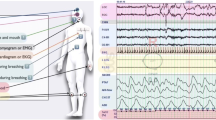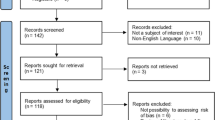Abstract
Purpose
Sleep disordered breathing (SDB) is common in children, resulting in extensive waiting lists for specialist clinics. There is an urgent need for a valid method of triaging patients and the OSA-18, a disease-specific tool, is an attractive candidate for this role. We aimed to examine the OSA-18 as a measurement tool in detail and to determine whether the score or aspects of it could be used as a screening tool for SDB in children.
Methods
Retrospective analysis of 582 children (6 months to 16.4 years)—216 underwent overnight PSG and 366 overnight oximetry. Confirmatory factor analysis (CFA) and exploratory factor analysis (EFA) were conducted. Receiver operating characteristic curve analysis assessed the diagnostic accuracy of the factors for the presence of OSA. Rasch analysis was used to assess the structure of the items (1–18) and categories of response (Likert scale).
Results
The CFA with a forced five-factor structure, revealed three factors with Eigenvalues >1, and explained 73.7 % of the variance. EFA resulted in a two-factor structure, explaining 60.3 % of the variance. Assessment of sensitivity and specificity showed a high false-positive rate, irrespective of the factor structure tested. Rasch analysis showed poor discrimination between adjacent categories on the Likert scale.
Conclusion
This study confirmed that the predictive value of the OSA-18 for SDB severity is weak. Some questions perform better than others statistically, and the seven categories of response introduce significant statistical noise, raising the possibility that modification of the OSA-18 may improve its performance in the prediction of OSA severity.
Similar content being viewed by others
References
Lumeng JC, Chervin RD (2008) Epidemiology of pediatric obstructive sleep apnea. Proc Am Thorac Soc 5:242–252
Spruyt K, Gozal D (2011) Pediatric sleep questionnaires as diagnostic or epidemiological tools: a review of currently available instruments. Sleep Med Rev 15:19–32
Cincin A, Sakalli E, Bakirci EM, Dizman R (2014) Relationship between obstructive sleep apnea-specific symptoms and cardiac function before and after adenotonsillectomy in children with adenotonsillar hypertrophy. Int J Pediatr Otorhinolaryngol 78:1281–1287
Ishman SL, Tawfik KO, Smith DF, et al. (2015) Screening for pediatric obstructive sleep apnea before ambulatory surgery. J Clin Sleep Med 11(7):751–75;
Franco RA, Jr., Rosenfeld RM, Rao M (2000) First place–resident clinical science award 1999. Quality of life for children with obstructive sleep apnea. Otolaryngol Head Neck Surg 123:9–16
Sohn H, Rosenfeld RM (2003) Evaluation of sleep-disordered breathing in children. Otolaryngol Head Neck Surg 128:344–352
Hasukic B (2013) OSA-18 survey in evaluation of sleep-disordered breathing in children with adenotonsillar hypertrophy. Mediev Archaeol 67:111–114
Fischer Y, Rettinger G, Dorn M (2006) Long term change in quality of life after adenotonsillectomy for pediatric obstructive sleep disorders. Laryngorhinootologie 85:809–818
Kang KT, Weng WC, Lee CH, Lee PL, Hsu WC (2014) Discrepancy between objective and subjective outcomes after adenotonsillectomy in children with obstructive sleep apnea syndrome. Otolaryngol Head Neck Surg 151:150–158
Ishman SL, Yang CJ, Cohen AP, et al. (2014) Is the OSA-18 predictive of obstructive sleep apnea: Comparison to polysomnography. Laryngoscope 125(6):1491–1495
Borgstrom A, Nerfeldt P, Friberg D (2013) Questionnaire OSA-18 has poor validity compared to polysomnography in pediatric obstructive sleep apnea. Int J Pediatr Otorhinolaryngol 77:1864–1868
Constantin E, Tewfik TL, Brouillette RT (2010) Can the OSA-18 quality-of-life questionnaire detect obstructive sleep apnea in children? Pediatrics 125:e162–e168
Nisbet LC, Yiallourou SR, Biggs SN, et al. (2013) Preschool children with obstructive sleep apnea: the beginnings of elevated blood pressure? Sleep 36:1219–1226
Iber C, Ancoli-Israel S, Chesson A. L, Quan SF (2007) The AASM manual for the scoring of sleep and associated events
Berry RB, Budhiraja R, Gottlieb DJ, et al. (2012) Rules for scoring respiratory events in sleep: update of the 2007 AASM manual for the scoring of sleep and associated eventsb. Deliberations of the Sleep Apnea Definitions Task Force of the American Academy of Sleep Medicine. J Clin Sleep Med 8:597–619
Nixon GM, Hyde M, Biggs SN, Walter LM, Horne RS, Davey MJ (2014) The impact of recent changes to the respiratory scoring rules in pediatrics. J Clin Sleep Med 10:1217–1221
Henson RK, Roberts JK (2006) Use of exploratory factor analysis in published research: common errors and some comment on improved practice. Educ Psychol Meas 66:393–415
Ford JK, MacCallum RC, Tait M (1986) The application of exploratory factor analysis in psychology: a critical review and analysis. Personnel Psychol 39:291–314
Gorsuch RL (1970) A comparison of biquartimin, maxplane, promax, and varimax. Educ Psychol Meas 30:861–872
Gorsuch RL (1997) Exploratory factor analysis: its role in item analysis. J Pers Assess 68:532–560
Fabrigar LR, Wegener DT, MacCallum RC, Strahan EJ (1999) Evaluating the use of exploratory factor analysis in psychological research. Psychol Methods 4:272–299
Cronbach LJ (1951) Coefficient alpha and the internal structure of tests. Psychometrika 16:297–334
Henson RK (2001) Understanding internal consistency reliability estimates: a conceptual primer on coefficient alpha. Meas Eval Couns Dev 34:177–189
Marcus CL, Moore RH, Rosen CL, et al. (2013) A randomized trial of adenotonsillectomy for childhood sleep apnea. N Engl J Med 368:2366–2376
Andrich D (1988) Rasch models for measurement. SAGE Publications CA, USA
Bond T, Fox M (2015) Applying the rasch model. Fundamental measurement in the human sciences, 3rd edn. Routledge NY, USA
Adams RJ, Khoo ST (1999) ACER QUEST: the interactive test analysis system Australian Council for Educational Research. Camberwell, Victoria
Goldstein NA, Fatima M, Campbell TF, Rosenfeld RM (2002) Child behavior and quality of life before and after tonsillectomy and adenoidectomy. Arch Otolaryngol Head Neck Surg 128:770–775
Mohsen N, Susan A, Shahin B, Soheila D (2014) Sleep related quality of life before and after adenotonsillar surgery in pediatric population. Int J Pediatr Otorhinolaryngol 78:330–333
Silva VC, Leite AJ (2006) Quality of life in children with sleep-disordered breathing: evaluation by OSA-18. Braz J Otorhinolaryngol 72:747–756
Gomes Ade M, Santos OM, Pimentel K, et al. (2012) Quality of life in children with sleep-disordered breathing. Braz J Otorhinolaryngol 78:12–21
Saeed M, Keens T, Stabile M, Bolokowicz J, Davidson Ward S (2000) Should children with suspected obstructive sleep apnea syndrome and normal nap sleep studies have overnight sleep studies? Chest 118:360–365
Nixon GM, Kermack AS, Davis GM, Manoukian JJ, Brown KA, Brouillette RT (2004) Planning adenotonsillectomy in children with obstructive sleep apnea: the role of overnight oximetry. Pediatrics 113:e19–e25
Mitchell RB, Kelly J, Call E, Yao N (2004) Quality of life after adenotonsillectomy for obstructive sleep apnea in children. Arch Otolaryngol Head Neck Surg 130:190–194
Acknowledgments
The authors would like to thank the children and families who participated in this study and the staff of the Melbourne Children’s Sleep Centre for their support. The authors thank Andrew Stephanou (Australian Council for Educational Research) for performing the Rasch analysis.
Author information
Authors and Affiliations
Corresponding author
Ethics declarations
Ethical approval for this study was granted by the Monash Health and Monash University Human Research Ethics Committees. Written informed consent was obtained from parents at the time of the clinical testing for use of data pertaining to the diagnostic PSG or home oximetry for research purposes. There was no monetary incentive for participation.
Funding
This study was supported by a National Health and Medical Research Council of Australia project grant (491001 and 1010810) and the Victorian Government’s Operational Infrastructure Support Program.
Conflict of interest
All authors certify that they have no affiliations with or involvement in any organization or entity with any financial interest (such as honoraria; educational grants; participation in speakers’ bureaus; membership, employment, consultancies, stock ownership, or other equity interest; and expert testimony or patent-licensing arrangements), or non-financial interest (such as personal or professional relationships, affiliations, knowledge or beliefs) in the subject matter or materials discussed in this manuscript.
Additional information
Lisa M. Walter and Sarah N. Biggs are co-first authors.
Rights and permissions
About this article
Cite this article
Walter, L.M., Biggs, S.N., Cikor, N. et al. The efficacy of the OSA-18 as a waiting list triage tool for OSA in children. Sleep Breath 20, 837–844 (2016). https://doi.org/10.1007/s11325-015-1289-5
Received:
Revised:
Accepted:
Published:
Issue Date:
DOI: https://doi.org/10.1007/s11325-015-1289-5




